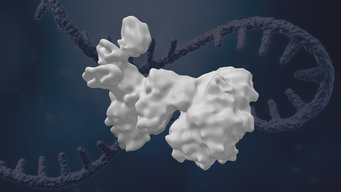Blueprint for proteins: How the mRNA gets its final shape
A team from the Max Planck Institue of Biochemistry in Martinsried and the Martin Luther University Halle-Wittenberg has discovered how an essential final step in the production of mRNA precisely works.
Proteins need to interact in a complex manner for a so-called “messenger RNA” (mRNA) to be created in human cells from a precursor molecule. mRNA provides a blueprint for proteins; the first vaccines against the coronavirus are also based on mRNAs. A team from the Max Planck Institute (MPI) of Biochemistry in Martinsried and the Martin Luther University Halle-Wittenberg (MLU) has discovered how an essential final step in the production of mRNA precisely works. The study was published in Genes & Development.

Proteins are responsible for all of the body’s essential processes. In a sense, the genes in the human genome act as building instructions for them. However, an intermediate step is necessary before new proteins can be created: “First the DNA must be transcribed: A chain-like precursor RNA is produced which is an exact copy of the DNA. From this, several steps are required to create the mature mRNA. This process is essential for the cell to build new proteins,” says biochemist Professor Elmar Wahle from MLU who led the team alongside Professor Elena Conti, an expert in structural biology at the MPI of Biochemistry.
There is no room for error in this complicated process - even the smallest changes in the structure of a protein can impair its function and lead to the development of diseases. “The mRNA not only determines the structure of a protein, but also how much of it is produced. Therefore, it is important that its structure is also precisely controlled,” Wahle adds. The proteins involved in reading out and transcribing DNA into precursor RNA are already known to scientists. However, an important sub-step in the process of creating mature mRNA has only been vaguely understood until now. First, the chains of the mRNA precursors are cleaved at a specific point to create uniform products. Then, a long molecular chain, the so-called poly(A) tail, is attached to one end of the strand. This ensures that the mRNA is not directly degraded again in the cells, and it is also important for protein synthesis.
The researchers from Halle and Martinsried joined forces to investigate these final steps in the production of mRNA more closely. To do this, the team from MLU first recreated the process in a test tube. The scientists had to pick the right proteins from a pool of 80 possible candidates. Those had to be mixed with the precursor RNA in a correct ratio before both reactions could take place. The researchers at MPI studied the process in more detail using cryo-electron microscopy. “We basically reproduced the conditions in a normal cell, although the natural process is probably even more complex,” explains Wahle. Sixteen proteins are involved in creating the final molecules. “The process is universal, affecting every cell and every mRNA molecule in the body,” says Felix Sandmeir from the MPI of Biochemistry.
On a side note, the process used to produce the Pfizer/Biontech and Moderna vaccines is much simpler: “The mRNA is created according to the same principle, but in contrast to the human cell, very simple enzymes are used and the complicated conversion of a precursor into the mature mRNA can be avoided,” says Wahle in conclusion. [TL]
The work was funded by the German Research Foundation (DFG).
Original publication:
M. Schmidt, F. Kluge, F. Sandmeir, U. Kühn, P. Schäfer, C. Tüting, C. Ihling, E. Conti, E. Wahle: Reconstitution of 3’- end processing of mammalian pre-mRNA reveals a central role of RBBP6, Genes & Development, February 2022
DOI: 10.1101/gad.349217.121












